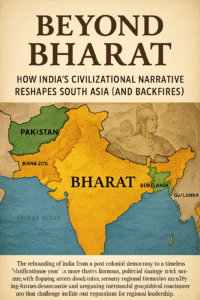Beyond Bharat: How India’s Civilizational Narrative Reshapes South Asia (and Backfires)
India’s push to redefine itself as a timeless Hindu civilizational state, while powerful domestically, is backfiring geopolitically across South Asia. The narrative, driven by the BJP and symbols like “Akhand Bharat,” amplifies the region’s deep-seated anxieties about Indian dominance, stoking fears of cultural absorption and territorial ambition.
This perceived threat is pushing smaller neighbors—already wary due to India’s immense size and past interventions—directly into China’s strategic embrace. China has capitalized on this distrust, surpassing India as the top trading partner for key states like Bangladesh and Pakistan, making significant infrastructure inroads (e.g., Hambantota), and positioning itself as a crucial security counterweight. The tangible fallout includes heightened border disputes (Nepal), expelled Indian forces (Maldives), and strained partnerships (Sri Lanka, Bangladesh).
Ultimately, India’s civilizational posture, intended to project strength and unity at home, is undermining its critical “Neighborhood First” policy, weakening its regional leadership, and actively facilitating China’s rise as the dominant external power in South Asia. This approach proves counterproductive, squandering the goodwill needed for genuine regional cooperation.

Beyond Bharat: How India’s Civilizational Narrative Reshapes South Asia (and Backfires)
The rebranding of India from a post-colonial democracy to a timeless “civilizational state” is more than a domestic political strategy. It’s a seismic shift rippling across South Asia, altering regional dynamics, amplifying historical anxieties, and triggering unintended geopolitical consequences that challenge India’s own aspirations for regional leadership.
From Nation-State to Civilizational Beacon: The Domestic Engine
At its core, the “civilizational state” narrative, championed by the ruling BJP, is a potent domestic tool:
- Rooted in Hindutva: It draws legitimacy from a reinterpretation of history, positioning modern India as the natural heir to ancient Vedic traditions, implicitly privileging Hindu identity.
- Symbolic Acts: The push to use “Bharat,” the G20 mural depicting the expansive Mauryan Empire, and the aspirational concept of “Akhand Bharat” (a unified subcontinent) serve as powerful visual and rhetorical anchors for this identity.
- Exceptionalism & Pride: It fuels “Vishwa Guru” (world teacher) aspirations and underpins initiatives like “Atmanirbhar Bharat,” fostering national pride in indigenous models over perceived Western imports. This narrative resonates deeply, offering a sense of historical grandeur and unified purpose.
The Geopolitical Blowback: Stoking Regional Fears
However, this inward-looking narrative collides violently with regional realities:
- The “Big Brother” Complex Amplified: South Asia already grapples with immense power asymmetry. India dominates geographically, demographically, and economically. The civilizational narrative, especially hints of “Akhand Bharat,” is perceived as thinly veiled irredentism – a cultural claim staking ownership over neighbors’ territory and identity. Pakistan, Nepal, and Bangladesh reacted swiftly to the Parliament mural, seeing it as a territorial threat.
- Feeding Anti-India Insecurities: Decades of interventionist policies (real or perceived) have fueled deep-seated suspicions. The civilizational narrative validates these fears, suggesting India views its neighbors not as sovereign equals, but as lost fragments of its own historical body politic. This pushes them to actively distance their national identities from India.
- China’s Opportunity: This fear and distrust creates a vacuum. China, itself a proponent of civilizational claims (e.g., Tibet, South China Sea), has adeptly positioned itself as the indispensable counterweight:
- Economic Leverage: China is now the largest trading partner for Bangladesh, Pakistan, Nepal, and Sri Lanka, surpassing India.
- Strategic Inroads: From the Hambantota Port in Sri Lanka and potential engagement with Bhutan to military ties with Pakistan and influence in Myanmar, China offers alternatives to Indian dominance.
- Exploiting Instability: Political turmoil in Afghanistan, Pakistan, Sri Lanka, and Nepal creates openings China readily fills, offering economic lifelines (often debt-trap diplomacy) and security partnerships India is reluctant or unable to match.
The Tangible Fallout: A Shifting Region
The consequences are starkly visible across the subcontinent:
- Border Tensions: Disputes with Nepal (Kalapani-Lipulekh) flare, fueled by historical sensitivities.
- Shrinking Influence: The expulsion of Indian military personnel from the Maldives signals a loss of trust. Bhutan cautiously exploring ties with China is a major strategic shift.
- Eroding Partnerships: Post-Hasina uncertainties in Bangladesh and China’s deep economic penetration strain a once-close relationship. Sri Lanka, despite historical ties, leans heavily on China for survival.
- Security Dilemma: India is no longer seen as the primary guarantor of regional security. Instead, China emerges as a crucial security counterweight against perceived Indian hegemony.
The Paradox: Aspiration vs. Reality
India’s civilizational narrative creates a dangerous paradox:
- Domestic Gain, Geopolitical Cost: While electorally potent at home, it actively undermines India’s “Neighborhood First” policy and its ambition to be a global power through regional leadership.
- Modernity vs. Tradition: The push for economic modernization and global integration clashes with the promotion of homogenized, tradition-based nationalism.
- Unity vs. Exclusion: The narrative centered on a “Hindu civilizational” past inherently marginalizes non-Hindu Indians and alarms neighboring Muslim-majority states like Bangladesh and Pakistan.
The Path Forward: Cooperation Over Civilizational Claims
The article highlights a critical lesson: India’s regional strength cannot be built on exclusionary historical narratives. The “civilizational state” posture, however popular domestically, is geopolitically counterproductive:
- Fuels Rivalry: It directly enables China’s strategic encroachment.
- Erodes Trust: It deepens the very insecurities that fracture regional cohesion.
- Hinders Integration: It works against the mutual economic interdependence (via SAARC, BIMSTEC) that could genuinely stabilize South Asia and amplify India’s global standing.
The Insight: True leadership in South Asia demands not assertions of ancient cultural supremacy, but a demonstrable commitment to respectful partnership, equitable economic integration, and unwavering respect for the sovereignty of neighbors. India’s future as a global power hinges less on reclaiming a mythical “Akhand Bharat” and more on building a collaborative, secure, and prosperous “South Asia First.” The cost of neglecting this reality is a region increasingly shaped by Beijing, not New Delhi.
You must be logged in to post a comment.